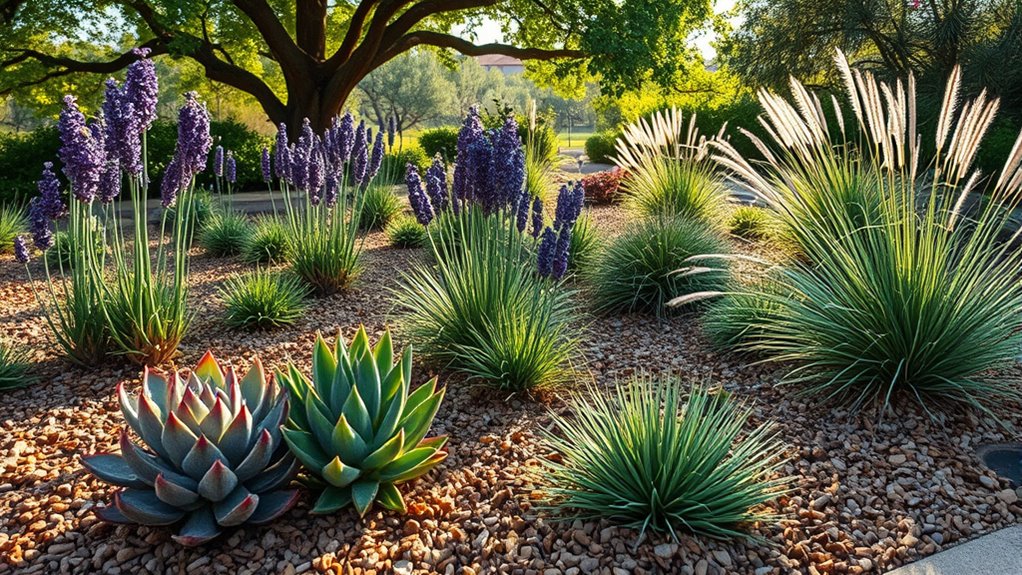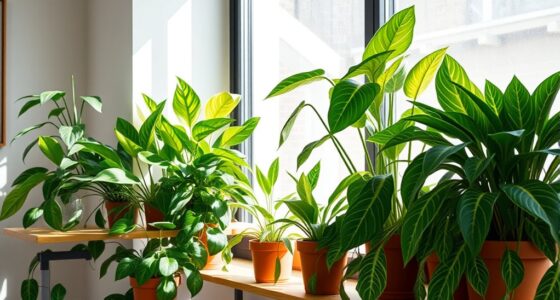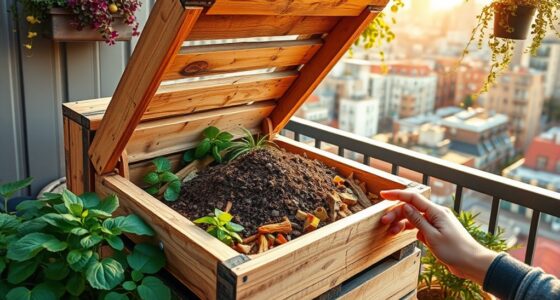To grow more with less water, focus on water-wise gardening principles like selecting drought-tolerant plants suited to your climate and grouping those with similar water needs. Incorporate mulch to retain soil moisture and reduce evaporation, and use efficient watering methods like drip irrigation during cooler times of the day. Replacing traditional lawns with native ground covers or decorative rocks also helps conserve water. Keep exploring further tips to create a sustainable and vibrant landscape without wasting resources.
Key Takeaways
- Select drought-tolerant, native, or adapted plants suited to your climate to reduce water needs.
- Use efficient watering methods like drip irrigation and schedule watering during early morning or late evening.
- Group plants with similar water requirements and apply mulch to conserve soil moisture.
- Replace traditional lawns with low-water ground covers, gravel, or decorative rocks to minimize irrigation.
- Regularly maintain irrigation systems and prune plants to promote healthy growth and water efficiency.

Water-wise gardening is an effective way to create a beautiful landscape while conserving this precious resource. If you want to reduce water use without sacrificing aesthetic appeal, understanding xeriscaping principles is essential. These principles guide you in designing landscapes that require minimal irrigation by selecting plants and materials suited to your local climate. One of the core ideas is to incorporate drought-tolerant plants that thrive with little water once established. These plants are specifically adapted to withstand dry conditions, making them ideal for water-wise gardens. By choosing native or adapted species, you can create a resilient landscape that looks vibrant year-round without the need for frequent watering.
Start by planning your garden layout around xeriscaping principles. This involves grouping plants with similar water needs together, which helps you target watering efficiently and avoids over- or under-watering certain areas. Incorporate mulch generously around plants to retain soil moisture, reduce evaporation, and suppress weeds. Select drought-tolerant plants that are suited to your soil type and sunlight exposure. These plants often have deep root systems that access underground water reserves, allowing them to survive droughts and heatwaves with ease. Examples include succulents, lavender, yarrow, and agave, which not only conserve water but also add texture and color to your landscape.
Another key aspect of water-wise gardening is reducing lawn areas, which typically require significant irrigation. Instead, consider replacing grass with ground covers, gravel, or decorative rocks that mimic natural landscapes. If you do want some grassy areas, opt for drought-resistant turfgrass varieties that need less water and fertilizer. Efficient watering techniques also play a role; using drip irrigation and soaker hoses delivers water directly to plant roots, minimizing waste. Water early in the morning or late in the evening to reduce evaporation and ensure plants absorb as much moisture as possible. Additionally, understanding the importance of necessary cookies helps improve website functionality and user experience, ensuring your gardening research remains accessible and tailored to your needs.
Maintenance is straightforward with this approach. Regularly check your irrigation system for leaks or clogged emitters, and adjust watering schedules based on seasonal changes. Keep your plants healthy by pruning and removing dead or diseased foliage, which helps them withstand drought stress better. Over time, you’ll notice your landscape becoming more sustainable and less dependent on supplemental watering, all while maintaining visual appeal. By following xeriscaping principles and selecting drought-tolerant plants, you create a landscape that’s both environmentally friendly and visually stunning, proving that you can grow more with less water.
Frequently Asked Questions
What Are the Best Native Plants for Water-Wise Gardens?
When choosing native plants for your garden, focus on regional landscaping to guarantee success. Native plant selection is key; look for drought-tolerant species that thrive with minimal water. You might consider options like lavender, yarrow, or coneflowers if they’re suited to your area. These plants not only conserve water but also support local pollinators, creating a sustainable and beautiful landscape that requires less maintenance and irrigation.
How Can I Prepare My Soil for Water Conservation?
Think of your soil as a sponge, ready to soak up what you give it. To prepare, you should enrich it with soil amendments like compost to improve water retention and nutrients. Use mulching techniques to cover the soil, reducing evaporation and keeping moisture steady. These steps create a resilient foundation, helping your garden thrive while conserving water. Your efforts turn dry soil into a vibrant, life-giving resource.
What Watering Techniques Minimize Water Waste?
To minimize water waste, you should use efficient watering techniques like drip irrigation, which delivers water directly to plant roots, reducing evaporation. Additionally, applying mulch helps retain soil moisture, limiting the need for frequent watering. By combining drip irrigation with mulch application, you guarantee your garden receives targeted, consistent moisture while conserving water and promoting healthy plant growth. This approach maximizes efficiency and minimizes waste effectively.
How Do I Maintain Drought-Tolerant Plants?
You maintain drought-tolerant plants by choosing the right plant selection suited for dry conditions. Mulching benefits include conserving soil moisture, reducing weeds, and regulating temperature, which helps your plants thrive with less water. Water deeply and infrequently to encourage deep roots, and avoid overwatering. Regularly check soil moisture and prune dead or unhealthy growth. This approach guarantees your drought-tolerant plants stay healthy and resilient in water-scarce conditions.
Are There Eco-Friendly Fertilizers Suitable for Water-Wise Gardening?
Imagine your garden as a thriving ecosystem where every element supports growth. You can choose eco-friendly fertilizers like organic composting and mineral supplements that nurture your drought-tolerant plants without wasting water. These sustainable options enrich the soil naturally, reduce runoff, and promote healthy roots. Embracing eco-conscious fertilizing methods guarantees your garden stays vibrant and resilient while conserving water resources, making every drop count in your water-wise gardening journey.
Conclusion
Now that you’ve learned the secrets of water-wise gardening, imagine what you could achieve with just a little more knowledge. Every drop saved brings you closer to a thriving, sustainable garden that could surprise you in ways you never expected. But there’s more to discover—hidden tips and tricks that could transform your entire approach. Are you ready to open the full potential of your garden and make every drop count? The journey is just beginning.









